Potty Training 3-Year-Olds: 11 Tips to Make It Easier
Potty training a 3-year-old can feel intimidating, but with the right approach, you can simplify the process greatly. By identifying the perfect time to start and establishing a structured routine, you can help your child become more comfortable with this change. Incorporating positive reinforcement and making the experience enjoyable can further enhance their willingness to engage. You might be surprised to learn some practical strategies that can make a lasting impact—especially when it comes to celebrating those small victories along the way. Curious about how to implement these tips effectively?
Start at the Right Time
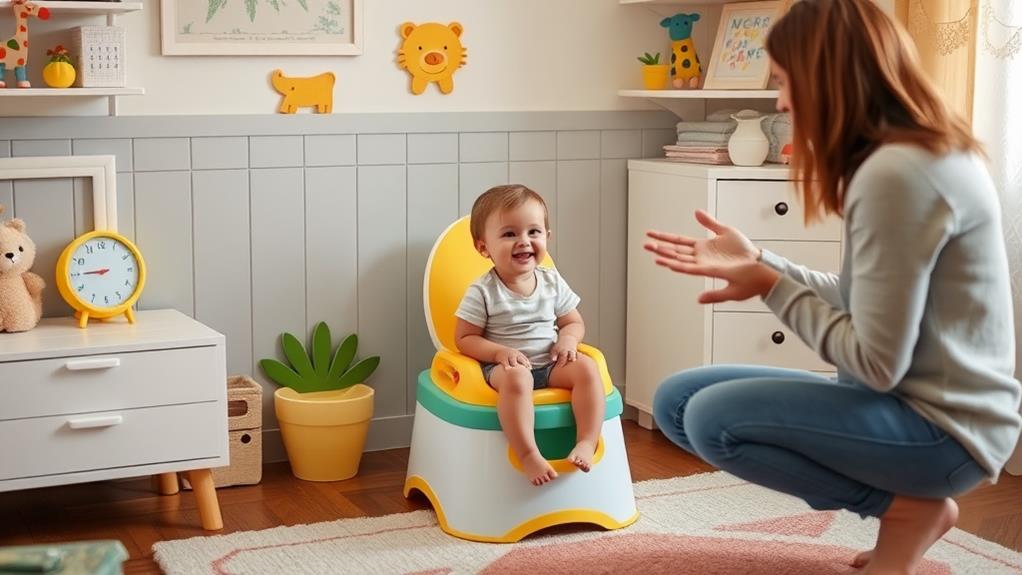
When you begin potty training your 3-year-old, timing is essential. You want to wait until they're ready, and that can be tricky to figure out. Look for signs like showing interest in the toilet, staying dry for longer periods, or even wanting to wear big kid underwear. If you notice these cues, it's a good indication that they're ready to take the plunge—pun intended!
Starting at the right time can make a huge difference in your child's success. If you push them too soon, you might find yourself cleaning up more messes than you'd like. On the other hand, waiting too long can lead to frustration for both of you.
Remember, every child is different, and there's no one-size-fits-all approach. You might also want to reflect on any changes happening at home, like a new baby or moving to a new house. These can be big distractions for your little one.
Once you feel the timing is right, roll up your sleeves and get ready for this exciting adventure. With a bit of patience and encouragement, you'll soon be celebrating those big potty wins together!
Create a Potty Schedule
How can you make potty training easier for your 3-year-old? One effective way is to create a potty schedule. Just like adults have routines, kids thrive on predictability.
Start by observing your child's natural patterns. Notice when they tend to go to the bathroom—after meals, before bedtime, or right after playtime.
Once you've got a good idea of their routine, set specific times throughout the day for potty breaks. You might begin with every two hours, gradually adjusting based on your child's needs.
Make it fun! Use a colorful chart where they can mark off each successful trip. You could even set a timer as a reminder; just make sure it doesn't sound too scary!
Also, keep in mind that accidents happen, and that's okay. The goal here is to create a comfortable environment where your little one feels safe to try. Encourage them to listen to their bodies and communicate when they need to go.
With a consistent potty schedule, you're not just helping them learn; you're also building their confidence. Who knew potty training could be such an adventure?
Use Positive Reinforcement
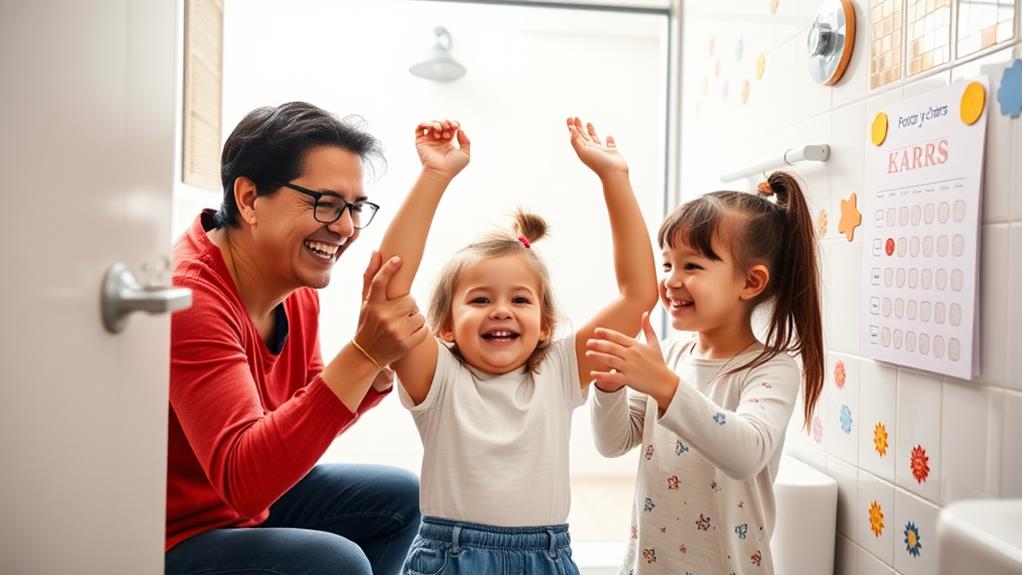
Using a potty schedule is just one part of the potty training journey; positive reinforcement plays a key role in motivating your 3-year-old. It's all about celebrating those little victories! When your child successfully uses the potty, let them know how proud you are. A simple high-five or a cheerful "You did it!" can make a huge difference.
Consider using a reward system too. Maybe you can create a sticker chart where your child earns a sticker for every successful trip to the potty. Once they collect a certain number, treat them to a small prize or a fun outing. This turns potty training into a game, making it exciting and enjoyable!
Be sure to keep the praise specific. Instead of just saying, "Good job," try saying, "I love how you told me you needed to go!" It helps your child understand exactly what they did right.
Choose the Right Equipment
What equipment do you need to make potty training easier for your child? First off, a kid-friendly potty chair or seat is essential. Kids love having their own special potty, and it can make them feel more in control. You can choose between a standalone potty or a seat that fits on your regular toilet. Just make sure it's comfortable and stable!
Next, consider potty training pants. These are great for little ones who are evolving from diapers. They're easy to pull up and down, helping your child feel independent. Plus, they help contain any little accidents while still being a step up from diapers.
Don't forget about wipes and toilet paper! Having these nearby makes clean-up easier and teaches your child good hygiene habits.
And, of course, a step stool is handy if you're using a regular toilet. This way, your child can easily climb up and feel secure.
Lastly, grab a fun chart or stickers to track progress. Celebrating milestones can keep your child motivated.
With the right equipment in place, you'll be on your way to a successful potty training journey!
Make It Fun and Engaging
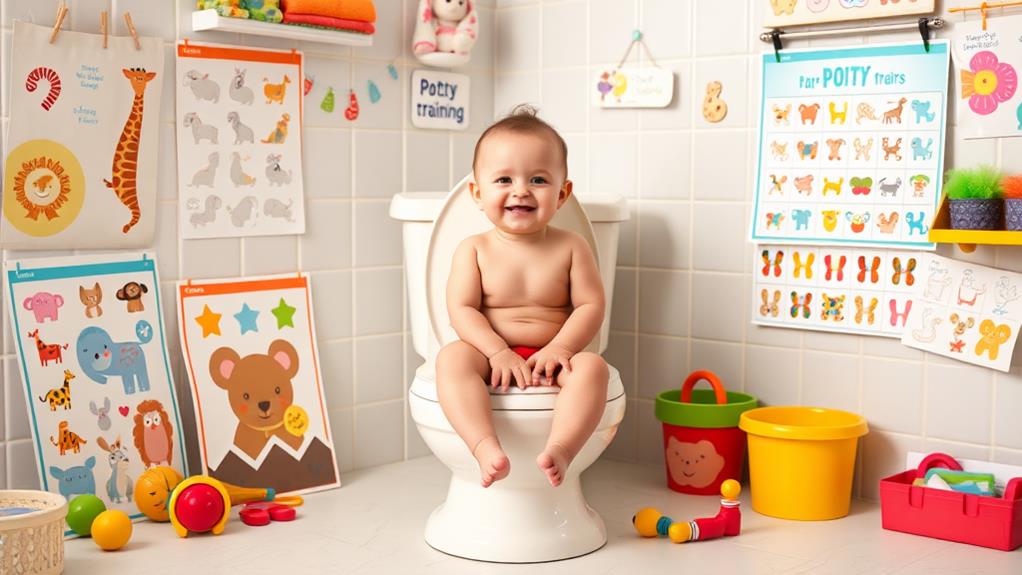
Potty training can be a delightful adventure when you make it fun and engaging for your child. Turn this process into a game! You could create a sticker chart where your little one earns a sticker for every successful trip to the potty. After reaching a certain number, reward them with a small treat or extra playtime. It's a win-win—your child feels accomplished, and you celebrate the milestones together.
You might also consider using fun potty songs or rhymes. Singing while they sit can lighten the mood and distract them from any nerves. Plus, who doesn't love a catchy tune?
Another idea is to let your child pick out some fun toilet paper or a special potty book. This makes the potty feel like their own special space.
Stay Consistent With Training
Consistency is key when it comes to successful potty training. You want to create a routine that your child can rely on. If you let them know it's potty time after meals or snacks, they'll start to expect it. This helps them recognize their body's signals, making it easier for them to respond when they need to go.
Try to keep the same words and phrases when you encourage your child to use the toilet. For example, use "time to use the potty" each time. This repetition helps them understand what you want them to do. Plus, it builds their confidence!
If you slip up occasionally, don't worry—everyone has off days! Just remember to stay positive and patient. If your little one has an accident, reassure them that it's perfectly normal. Reacting calmly teaches them that it's not a big deal, and they'll be more willing to try again next time.
In the end, the more consistent you are, the more successful potty training will be. You're laying the groundwork for your child's independence, and that's something to celebrate, even if it does come with a few messes along the way!
Encourage Independence
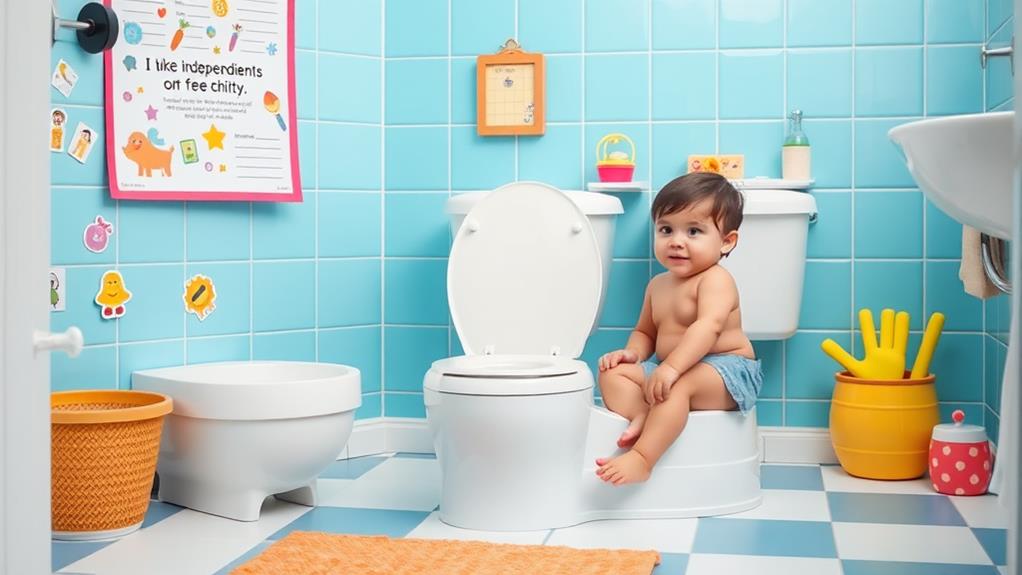
As your child becomes more familiar with the potty routine, it's important to encourage their independence in the process. You want them to feel confident and capable, so let them take the lead where they can.
Start by letting your little one choose their own underwear. Trust me, nothing says "big kid" like a pair of superhero or princess undies!
Next, give them some control over the timing. Ask your child when they think they need to go, rather than just saying, "It's time!" This helps them connect their body signals to the potty.
Also, let them practice pulling their pants up and down by themselves. Sure, it might take a little longer at first, but it's a great way for them to feel accomplished.
Lastly, consider setting up a potty chart where they can track their successes. A sticker for each time they use the potty can work wonders!
Just remember to celebrate the wins, even the tiny ones. After all, every step towards independence is a victory. So, sit back, cheer them on, and watch as they master this milestone!
Communicate Openly
Encouraging your child's independence naturally leads to the importance of open communication. When it comes to potty training, talking openly about what's happening can make a big difference.
Try to create a relaxed atmosphere where your child feels comfortable sharing their thoughts and feelings. Ask them how they feel about using the potty, and listen closely to what they say. You might be surprised by their insights!
Use clear, simple language to explain the process. Share what's going to happen next and why it's important. For example, you can say, "Using the potty helps you stay dry and feel good!" This helps them understand that potty training is a big step towards being a "big kid."
Also, encourage your child to ask questions. They might wonder why they can't just wear diapers forever—trust me, it's a valid question! Be patient and answer honestly, making it a fun conversation.
Handle Accidents Calmly

When accidents happen, it's crucial to keep your cool and not let frustration bubble over. Remember, potty training is a big deal for your little one, and accidents are just part of the journey. Instead of reacting with anger or disappointment, take a deep breath and approach the situation calmly. Your child is learning, and they need your support.
First, reassure them that it's okay. You might say something like, "Oops! That happens sometimes!" This helps them feel safe and less embarrassed. Avoid scolding, as it can make them associate potty training with fear instead of excitement.
Next, clean up the mess together. Make it a light-hearted activity! You could even joke about how you're a "super mess cleaner" getting rid of "potty pirates." This keeps the mood light and reinforces teamwork.
Be Patient and Understanding
Potty training can be a challenging process, and it's essential to be patient and understanding during this time. Remember, your child's learning curve mightn't match your expectations. They may have good days and not-so-good days, and that's perfectly normal. It's all part of the journey!
When accidents happen—and they will—take a deep breath and keep your cool. Yelling or showing frustration can make your child feel anxious or ashamed, which isn't helpful at all. Instead, reassure them that it's okay to make mistakes. Getting upset won't speed up the process, and it might even slow things down.
Encourage your little one by reminding them that everyone learns at their own pace. Celebrate the small victories, but don't sweat the setbacks. If they're hesitant or scared, try to understand their feelings. Perhaps they need a little more time or a different approach.
You're both in this together, so be their biggest cheerleader. With a sprinkle of patience and a dash of understanding, potty training can become a positive experience for both of you.
Celebrate Successes Together
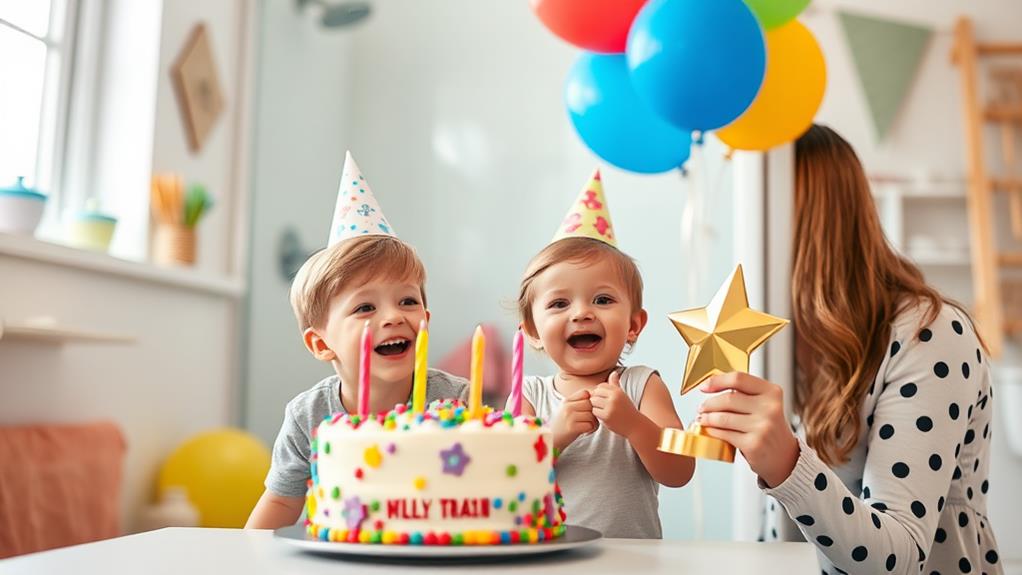
Celebrating successes together can make potty training a fun and rewarding experience for both you and your child. When your little one uses the toilet successfully, it's a big deal! Acknowledge this milestone with cheers, high-fives, or even a silly dance. Your enthusiasm will show them just how proud you are, and it'll motivate them to keep going.
Consider creating a rewards chart. You can add stickers for each successful trip to the potty. Watching those stickers add up can be exciting for your child!
But remember, it doesn't have to be all about the rewards—simple praise goes a long way too. Say things like, "You did it! I'm so proud of you!" Your words can light up their face.
You might even make it a family event. Invite siblings to join in the celebration, or plan a small treat when they reach a goal.
Just keep the focus on fun. Potty training can be tough, but celebrating each little victory helps everyone enjoy the process. So, let's keep the mood light, and remember—every success, no matter how small, is worth celebrating!

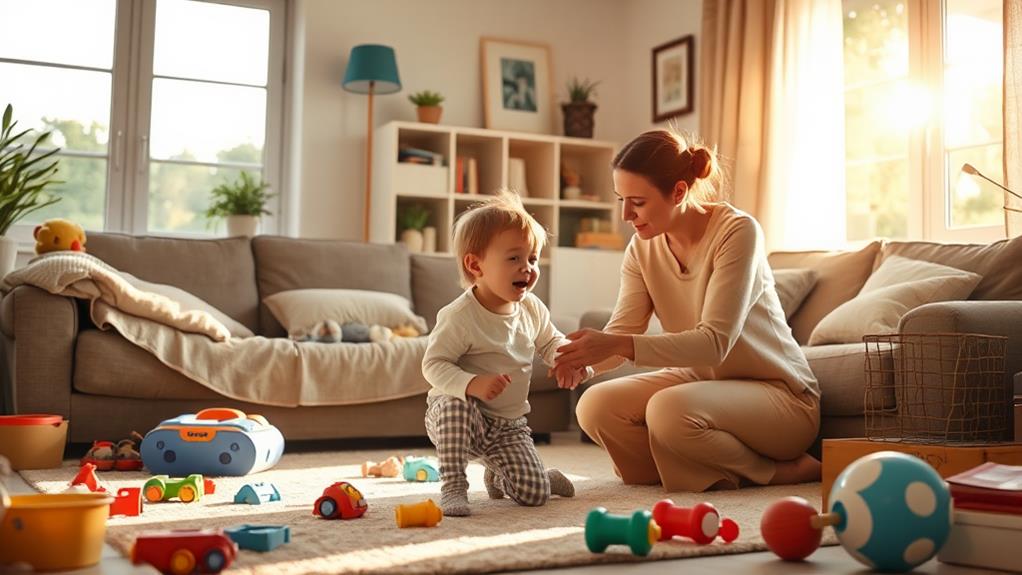
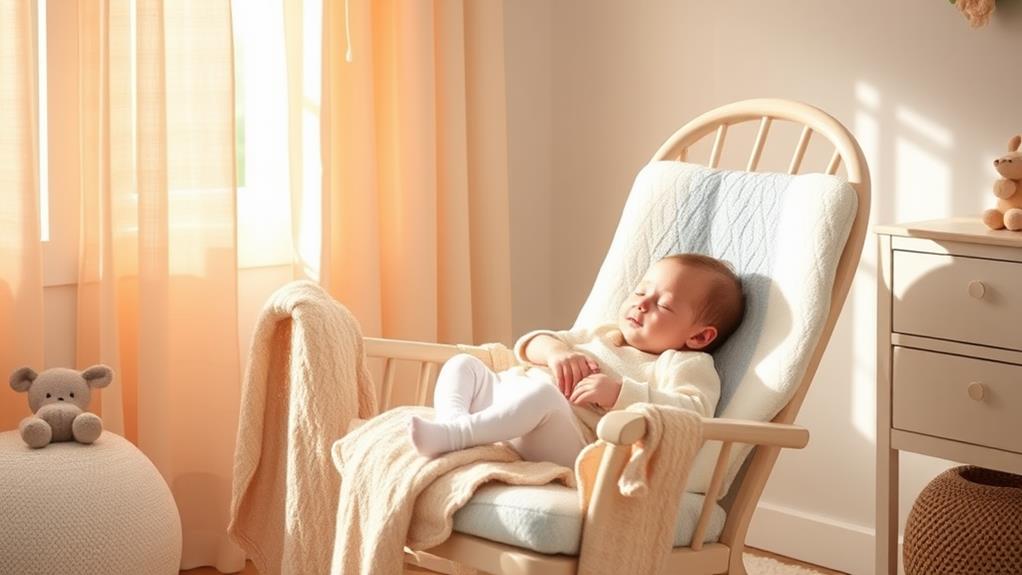
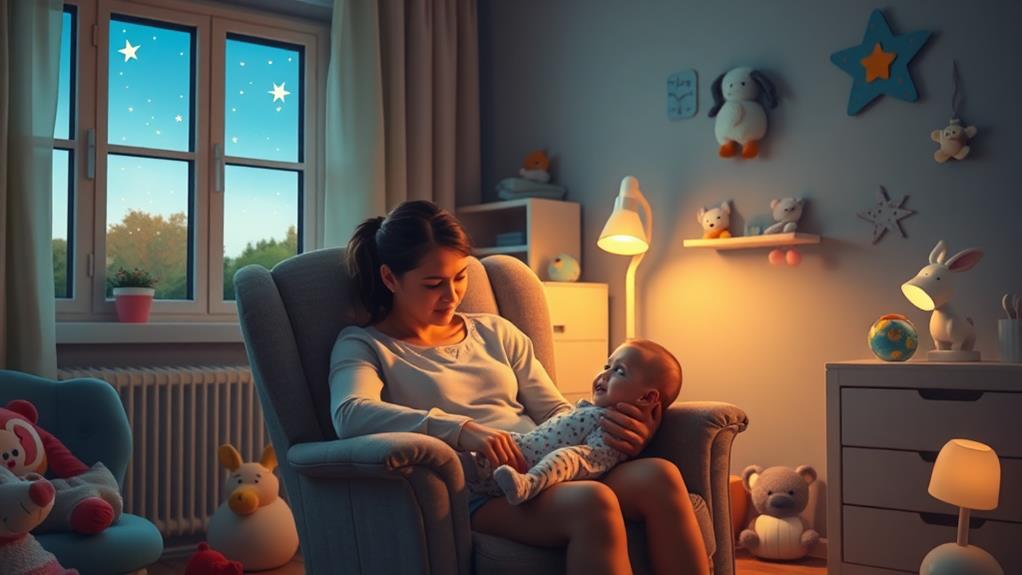










Post Comment